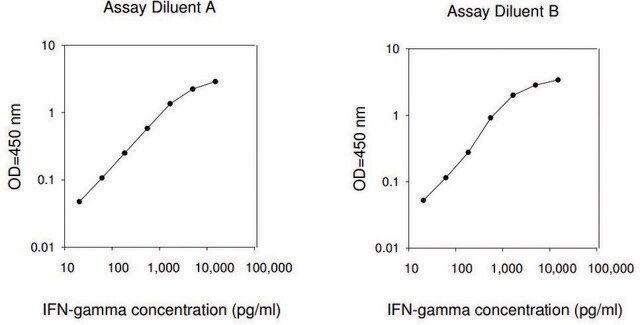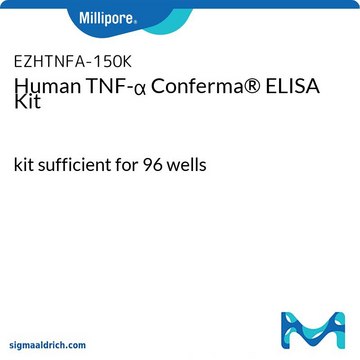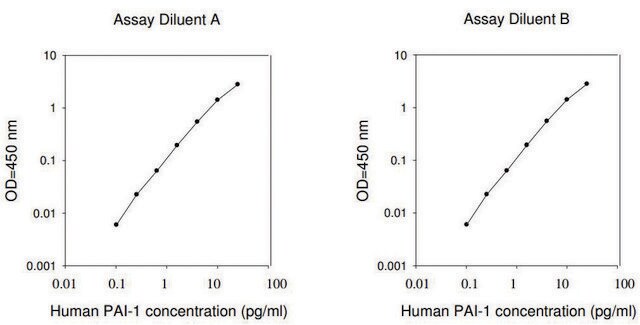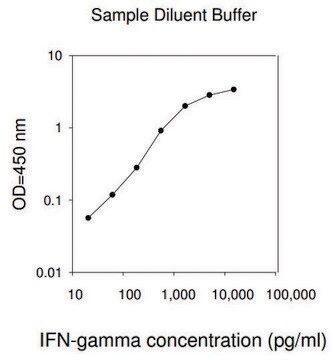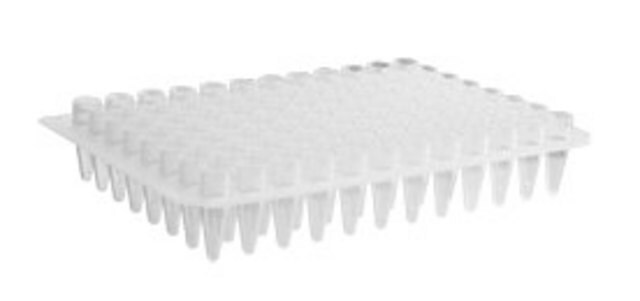RAB0541
Human IFNA1 / Interferon Alpha-1/13 ELISA Kit
for serum, plasma, cell culture supernatants and urine
Zaloguj sięWyświetlanie cen organizacyjnych i kontraktowych
About This Item
Kod UNSPSC:
41116158
NACRES:
NA.32
Polecane produkty
reaktywność gatunkowa
human
opakowanie
kit of 96 wells (12 strips x 8 wells)
metody
ELISA: suitable
moc wejściowa
sample type cell culture supernatant(s)
sample type serum
sample type plasma
sample type urine
assay range
inter-assay cv: <10%
intra-assay cv: <12%
sensitivity: 0.6 ng/mL
metoda wykrywania
colorimetric
Warunki transportu
wet ice
temp. przechowywania
−20°C
informacje o genach
human ... IFNA1(3439)
Opis ogólny
Ta para przeciwciał ELISA wykrywa ludzki interferon alfa-1/13.
Zastosowanie
For research use only. Not for use in diagnostic procedures.
Please refer to the attached General ELISA KIT Procedure (sandwich, competitive & Indirect ELISA)
Please refer to the attached General ELISA KIT Procedure (sandwich, competitive & Indirect ELISA)
Inne uwagi
Dla tego produktu dostępny jest przykładowy certyfikat analizy.
Wpisz słowo sample w polu tekstowym przeznaczonym na numer partii.
Wpisz słowo sample w polu tekstowym przeznaczonym na numer partii.
Ta strona może zawierać tekst przetłumaczony maszynowo.
Elementy zestawu są też dostępne oddzielnie
Numer produktu
Opis
Karta charakterystyki
- RABTMB3ELISA Colorimetric TMB Reagent (HRP Substrate, Item H)Karta charakterystyki
- RABSTOP3ELISA Stop Solution (Item I)Karta charakterystyki
- RABELADAELISA 1X Assay/Sample Diluent Buffer A (Item D1)Karta charakterystyki
- RABELADBELISA 5X Assay/Sample Diluent Buffer B (Item E1)Karta charakterystyki
- RABWASH420X Wash Buffer (Item B)Karta charakterystyki
Hasło ostrzegawcze
Warning
Zwroty wskazujące rodzaj zagrożenia
Zwroty wskazujące środki ostrożności
Klasyfikacja zagrożeń
Met. Corr. 1
Kod klasy składowania
8A - Combustible corrosive hazardous materials
Temperatura zapłonu (°F)
Not applicable
Temperatura zapłonu (°C)
Not applicable
Wybierz jedną z najnowszych wersji:
Masz już ten produkt?
Dokumenty związane z niedawno zakupionymi produktami zostały zamieszczone w Bibliotece dokumentów.
Benjamin J Murdock et al.
Journal of immunology (Baltimore, Md. : 1950), 193(8), 4107-4116 (2014-09-17)
The potent immunoregulatory properties of IL-10 can counteract protective immune responses and, thereby, promote persistent infections, as evidenced by studies of cryptococcal lung infection in IL-10-deficient mice. To further investigate how IL-10 impairs fungal clearance, the current study used an
Samuel T Haile et al.
Cancer immunology research, 2(7), 610-615 (2014-05-14)
Tumor cells use various methods of immunosuppression to overcome antitumor immunity. One such method is that of programmed death ligand-1 (PD-L1 or B7-H1), which upon binding its receptor PD-1 on T cells triggers apoptotic death of the activated T cells.
Yong-Chen Lu et al.
Clinical cancer research : an official journal of the American Association for Cancer Research, 20(13), 3401-3410 (2014-07-06)
Cancer immunotherapy with adoptive transfer of tumor-infiltrating lymphocytes (TIL) represents an effective treatment for patients with metastatic melanoma, with the objective regressions in up to 72% of patients in three clinical trials. However, the antigen targets recognized by these effective
Shuxian Hu et al.
PloS one, 9(8), e105219-e105219 (2014-08-19)
The ability of neural stem/progenitor cells (NSCs) to self-renew, migrate to damaged sites, and differentiate into neurons has renewed interest in using them in therapies for neurodegenerative disorders. Neurological diseases, including viral infections of the brain, are often accompanied by
Vibha Jha et al.
PloS one, 9(8), e104484-e104484 (2014-08-15)
Environmental factors including drugs, mineral oils and heavy metals such as lead, gold and mercury are triggers of autoimmune diseases in animal models or even in occupationally exposed humans. After exposure to subtoxic levels of mercury (Hg), genetically susceptible strains
Nasz zespół naukowców ma doświadczenie we wszystkich obszarach badań, w tym w naukach przyrodniczych, materiałoznawstwie, syntezie chemicznej, chromatografii, analityce i wielu innych dziedzinach.
Skontaktuj się z zespołem ds. pomocy technicznej